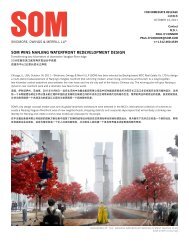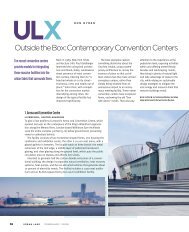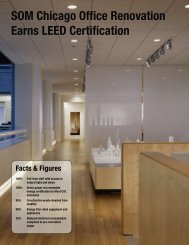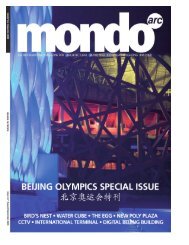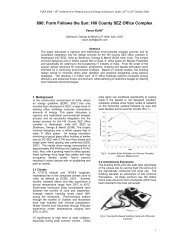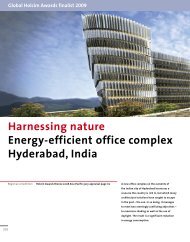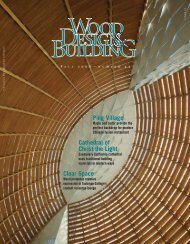THE PERFORMATIVE - Skidmore, Owings & Merrill LLP
THE PERFORMATIVE - Skidmore, Owings & Merrill LLP
THE PERFORMATIVE - Skidmore, Owings & Merrill LLP
You also want an ePaper? Increase the reach of your titles
YUMPU automatically turns print PDFs into web optimized ePapers that Google loves.
<strong>THE</strong> <strong>PERFORMATIVE</strong> WORKPLACE<br />
firms each have unique spatial requirements. Technologysavvy<br />
knowledge workers may require less support space and<br />
personnel, allowing a corporation to adopt a more efficient<br />
layout. By calculating the ideal size for workstations, designers<br />
can reduce a company’s footprint by 25% or more. In turn,<br />
if individual heads-down space becomes smaller, a modest<br />
increase in social and team space often boosts productivity by<br />
stimulating collaboration.<br />
motorized vertical blind<br />
wall support grid<br />
perimeter chilled beam<br />
active chilled beam<br />
light fixture<br />
chilled beam<br />
Of course, it would be a mistake for any company to design<br />
with only today’s needs in mind. Agile corporations<br />
need to plan for multiple futures, making office<br />
design an open-ended problem. Designers should<br />
favor “looser” workplace models that can be adapted without<br />
costly architectural reconfiguration. For example, bench<br />
systems provide greater elasticity than cubicles because they<br />
can accommodate varying numbers of workers doing different<br />
kinds of tasks. Single- or multi-floor neighborhoods of related<br />
employees can be designed to expand or contract rapidly if the<br />
company needs to reorganize.<br />
Strategic Infrastructure<br />
Every component of a high-performance workplace should be<br />
conducive to the task at hand. The office’s environmental<br />
infrastructure should be viewed as a strategic<br />
armature that creates ambient conditions<br />
conducive to work and makes it possible<br />
to reconfigure modular components easily.<br />
Calibrating this workplace model is a critical step in the design<br />
process, and may require testing multiple solutions or building<br />
a pilot to fine-tune the system.<br />
For example, well-designed lighting can reduce eye strain and<br />
fatigue, substantially boosting productivity.³ In a performative<br />
workplace, natural light provides primary illumination,<br />
with photosensors automatically controlling blinds and<br />
supplementing changing daylight conditions with electric light.<br />
An old, glare-producing ceiling with areas of high and low<br />
intensity can be replaced by a continuous low-contrast plane of<br />
light. Newer buildings often use pendant lights shining upward<br />
to create a luminous ceiling plane and illuminate the work<br />
surface indirectly, shifting the old 9’-0” ceiling height to a new<br />
9’-6” standard.<br />
Inside Chicago’s landmark Inland Steel Building, SOM designed an integrated<br />
workplace for businesses that need to facilitate radical organizational change.<br />
The infrastructure includes active chilled beams, triple-glzaed windows, and lowglare<br />
lighting.<br />
These lighting components can be integrated into modular<br />
ceilings with fire protection devices, acoustical control surfaces,<br />
and other building systems. Power and communications can be<br />
distributed under lift-out floor modules. Air can be distributed<br />
under the floor, too, saving energy and increasing indoor air<br />
quality by delivering clean, conditioned air close to employees.<br />
The key is to design these infrastructure components as<br />
integrated systems, scientifically analyzing and optimizing<br />
each component. Using Building Information Modeling (BIM)<br />
technology, designers can study exactly how much natural<br />
light can be harvested. The effects of different air conditioning<br />
systems can be simulated to compare effectiveness and<br />
operating costs. Digital tools allow the design firm to hone the<br />
workplace for peak performance like a meticulously-engineered<br />
product.<br />
³ Ahmet Cakir, Light and Health: Influences of Lighting on Health and Well-Being of Office and Computer Workers (Berlin: Ergonomic Institute of Social and<br />
Occupational Sciences, 1991), 7-9



